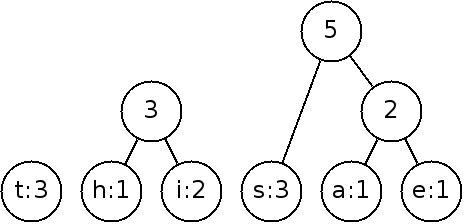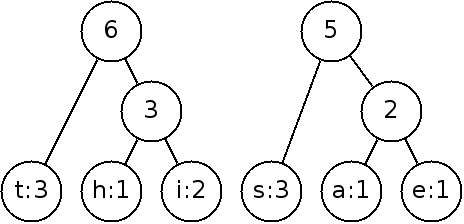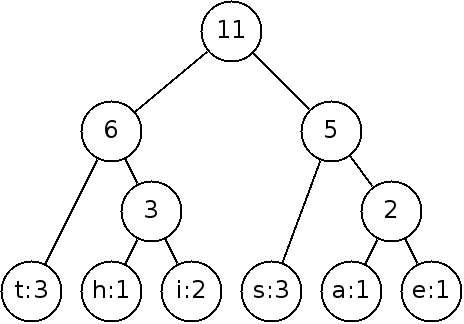Huffman Coding
Introduction
Huffman coding is a simple method of data compression. In data compression we want to represent some information in the smallest memory space possible. There are two main types of compression:
- Lossy: some data is lost in the process (.jpg, .mp3, etc.)
- Lossless: no data is lost in the process (.png, .flac, .zip etc.)
Huffman coding uses lossless compression.
We will use the following terms when discussing encoding:
Symbol
A symbol is a representation of a single piece of information.
Code
A code is the set of possible symbols.
Sentence
A sentence is a sequence of symbols representing some message.
For example, if we have the code:
{3, 7, 14, 18, 29, 35, 42, 56}
7, 42, 3, 35, 56, 3
42, 7
3, 3, 3, 35
Prefix Codes
A prefix code is a set of words with the prefix property. This states that for each word in the code, no valid word is the prefix for another.
{4, 5, 34, 37, 95}
{4, 5, 54, 37, 95}
Is not a prefix code because "5" is the prefix of another word "54".
The benefit of a prefix code, is that, given the code, we can identify the individual words without breaks:
Code: {4, 5, 34, 37, 95}
Sentence: 45349553745
What are the symbols in this sentence?
For compressing data, this means we don't have to include separators in the output.General Idea
The idea behind Huffman coding is that certain pieces of information in the input are more likely to appear than others. We will give these common symbols shorter codes to conserve space.
For simplicity, we will consider lower-case letters as our words. In English, for example, some letters are much more likely to appear.
This is true for most types of data, allowing for compact representations.
Binary Tree Representation
A Huffman code works by creating a tree to store the possible symbols. The code used for each symbol is the path from the root to that symbol. For the text:
this is a test
{t, h, i, s, a, e}
{t:3, h:1, i:2, s:3, a:1, e:1}
Now we will and create nodes for each symbol:

Building The Tree
Next, we will construct the tree by repeatedly joining the nodes with the smallest weights until it is a full tree. When there is a tie, it doesn't matter which weights we pick.

The weight of the new node is that of the sum of the children.
By continuing on:




To implement this, we need to keep track of the nodes that we can link and choose the smallest weight each time. This is best done with a priority queue (heap)!
- Create a priority queue of nodes such that they are ordered by smallest probability.
- Create a leaf node for each input symbol, and add it to the queue.
- While there is more than one node in the queue:
- Remove the two next nodes from the queue.
- Create a node linking these two as children, with probability of the two children summed.
- Add this node to the queue.
- The one node in the queue is now the root of the complete tree with probability = 1.0
What is the Big-O of this algorithm?